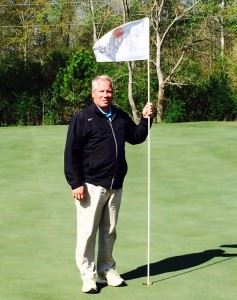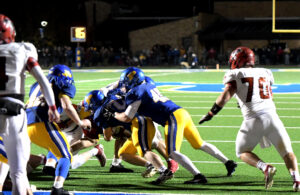Major influence
- Updated: April 8, 2015
Grubbs gives Cider Ridge a local connection to Augusta National, Masters

Cider Ridge assistant superintendent John Grubbs resets the flag on the fourth green. Grubbs spent nearly 20 years working at Augusta National.
By Al Muskewitz
East Alabama Sports Today
OXFORD — The week of the Masters is John Grubbs’ favorite week of the year. It has been for a long time.
Like millions around the world, Grubbs will take every chance he can this week to find a television and check on the drama unfolding at Augusta National. But he watches it a little different than the general golf fan.
Oh, he’ll be watching to see if Rory finally gets his green jacket and completes the career Grand Slam, or the direction Tiger goes in his latest return to the game or any of the other storylines that will unfold this week.
But he’ll be just as interested to see how the bunkers play or how the greens receive all those dramatic shots or how putts roll on Augusta’s famously fast and undulating greens.
“That’s how I watch almost all the tournaments I’ve watched,” he said.
Call it force of habit. Like a sportswriter who can’t watch a baseball game without keeping a scorecard, Grubbs watches the way the golf course plays — and he knows the subtleties of this course better than most.
That’s because he worked at the National for nearly 20 years before joining Oxford’s Cider Ridge Golf Club as one of two superintendent’s assistants — first in the pro shop, then later outside as the Par-3 foreman and eventually a supervisor over the most famous nine holes in championship golf.
Talk about having a front row seat to some of the best golf in the world. What the players, patrons and global television audience get to see this week, he saw every day.
“The consistency is what makes that place so … great,” Grubbs said. “I was there for a good while, but the person who was behind me training the whole time or comes in, we’re all trained the exact same way. Complete attention to detail, every little detail, and that’s the main thing that sets that course aside from everything else. That’s why it’s the No. 1 manicured course in the world, that attention to detail.
“We see more than what anybody else sees; the patrons don’t see anything we see. There would be something over there and we could say it’s not a big deal they’re not going to see it anyway, but that’s not how we went about things. We did the smallest thing, anything you saw out of place.”
There’s not a golfer on the planet who wouldn’t jump at the chance to be connected with the National, but Grubbs may be one of the few who ever turned them down.
His mother worked in the pro shop and the club asked if he’d like to help during the tournament. He did and shortly thereafter it offered him a chance to work in the shop full time, but he turned it down because he was about to start an apprenticeship as a pipefitter.
Luckily, the club called back and he didn’t have to be asked twice.
Grubbs spent four years in the pro shop, at a time when renowned instructor and Golf Channel host Michael Breed was there. He eventually moved outside where he stayed until 2010. He was a foreman on the Par-3 Course before moving to the big course where he ultimately supervised the crews on the back nine, where tradition has it the Masters doesn’t start until it gets there on Sunday afternoon.
He joined Cider Ridge in 2012, and has helped incorporate some of Augusta’s maintenance practices there, most notably in its bunker program.
Part of his duties on the back nine included overseeing the conditions on Amen Corner, checking the bent, setting the cups and making sure everything was absolutely perfect.
Grubbs enjoys talking about his experience at Augusta, but there still are things he can’t talk about. Like the speed of the greens during the Masters — “Tournament speed,” he said. He did allow they were “quite a bit” quicker than the normal 9.5-10 they run at peak season at Cider Ridge.
He did debunk as “completely false” the myth course officials pack the azaleas in ice to ensure they are perfect for tournament week or that artificial flowers are brought in when they’re not.
The most dramatic changes at the course took place during his tenure there and he said it was “neat” watching them develop. The addition of “rough” was dramatic if only from the standpoint of defining fairways, but the most significant by far is the lengthening that has taken place since Tiger Woods won in record fashion in 1997.
The thing about the changes, once they were implemented, they looked like they were there all along.
”It was neat being on that part,” he said. “It was always exciting, especially getting close to tournament time. Everybody busted their humps all year long to get ready for that tournament and then when you get to see the fruits of your labor, it doesn’t get any better than that. To see all the people so excited about the work your crew has done, that’s the best part of it.”
Playing it is even better. Ask him how many times he’s played it and he chuckles. As an employee, he had the privilege of playing it “at least 100 times.” The first time he ever played it, he shot 84. His best score is 74 and he’s never shot worse than an 85.
“Mainly because I was so used to those greens, so the speeds didn’t worry me; I loved it,” he said.
Of course, it always helped knowing the guy setting up the course.
“On play dates, I always tried to set it up so that I had some good pin positions,” he said.









You must be logged in to post a comment Login